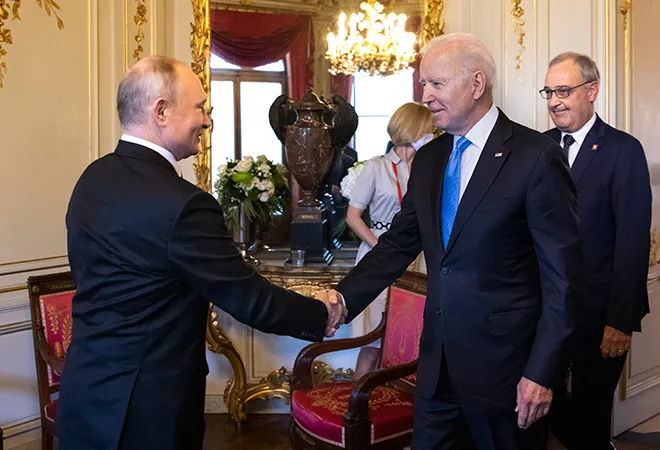
The recent
meeting between US President Joe Biden and Russian President Vladimir Putin in Geneva comes as a welcome change to the extremely tense relationship between Washington and Moscow in recent times. The summit, which ned over three hours, saw the two leaders discussing many pressing issues, including nuclear weapons and arms control. The future of the global nuclear nonproliferation order is partially predicated upon a commitment from both the US and Russia to collectively work towards building agreements and collaborating on limiting the spread and expansion of nuclear weapons.
Nuclear weapons have remained a critical point of tension between the US and Russia. Both nations possess over
90 percent of the world’s nuclear weapons. The Trump administration’s interest in eliminating nuclear agreements such as the Intermediate-Range Nuclear Forces Treaty (
INF) and the
New Strategic Arms Reduction Treaty (START) further
brought considerable strain on the bilateral relationship and the global nuclear order. In the context of the US and Russia, the demise of the INF treaty increased tensions between the two countries. The New START entered into force in 2011 and significantly reduced both countries’ strategic nuclear arsenals. In 2019, the likelihood of the treaty’s extension was bleak with both sides
expressing disinterest in its extension. Under the Trump administration, the New START failed to gain traction and the relations between the countries worsened. The tensions raised concerns about the possibility of a new nuclear arms race.
Under the Trump administration, the New START failed to gain traction and the relations between the countries worsened. The tensions raised concerns about the possibility of a new nuclear arms race
Although the diplomatic relations deteriorated, with Biden coming into power in the US, the extension of New START until 2026 helped take a step towards limiting long-range nuclear weapons. Further, the recent summit has provided the opportunity for the two countries to lead the way towards a new phase of arms control. Both leaders have agreed to negotiate ways to reduce the risk of nuclear war between the large nuclear powers through a series of negotiations under a “
strategic stability dialogue”.
The details of what these negotiations would entail are yet to be discussed, but require serious considerations of several
disagreements that exist between the US and Russia. Under the new arms control discussion, Washington has argued for the inclusion of tactical nuclear weapons as well as new and emerging technologies, and Moscow has expressed interest in including defensive weapons. Additionally, the US is keen on new agreements bringing China under the ambit of arms limitations.
It is also important to note that although the estimated number of nuclear weapons globally has
dropped in the past year, the estimated number of nuclear weapons currently deployed has
increased. On a more positive note for nuclear arms reduction, both the US and Russia continue to work towards reducing their overall nuclear weapons inventories. However, it must be noted that, the two countries have
increased the number of nuclear warheads in operational deployment.
Both the US and Russia continue to work towards reducing their overall nuclear weapons inventories. However, it must be noted that, the two countries have increased the number of nuclear warheads in operational deployment
The success (or failure) of arms reduction is
predicated upon the clarity with which a new treaty between the two countries is discussed. Without a treaty, the possibility of the buildup of nuclear weapons, missiles, and warheads, for either side increases. The discussions of the New START in 2009 and its subsequent enforcement was the result of clear and concise instructions from both sides to negotiate an arms control treaty that would work.
Similarly, Washington and Moscow need to establish clear areas that a future arms control dialogue would cover, in order to arrive at the best possible outcome. Given the tension between the two countries and the concern for global nuclear stability, it is crucial for both nations to identify and prioritise what a follow-on agreement would include. As the deployment of nuclear weapons increases, the nuclear nonproliferation order is further strained. The recent summit is a much-needed push towards bringing in a new phase of arms control. However, the lack of identification of possible areas for cooperation and sorting out potential areas of disagreement between Washington and Moscow would be detrimental to the success of any future talks. It is important for both countries to assess and articulate their priorities—whether it is national security concerns or strategic motivations—going forward and come to the negotiation table with a clear and concise idea on future cooperation, in order to avoid a more aggressive arms race.
The views expressed above belong to the author(s). ORF research and analyses now available on Telegram! Click here to access our curated content — blogs, longforms and interviews.



 The recent
The recent  PREV
PREV


